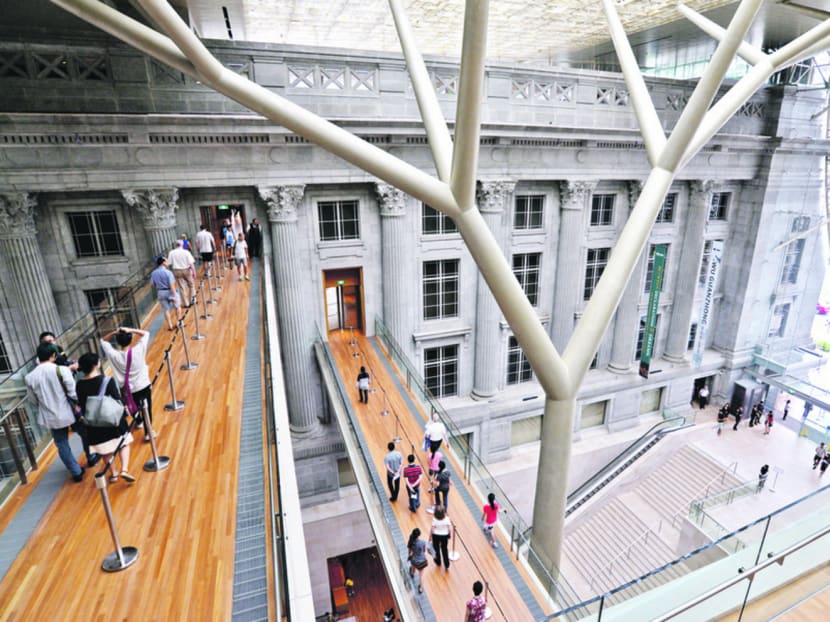Reflecting on National Gallery Singapore’s 'Empire Ball' outcry
SINGAPORE — Earlier this week, National Gallery Singapore caused an outcry with its announcement of a fundraising gala event themed Empire Ball, drawing instant furore from the artistic community. It was forced to change the theme of the event to the National Gallery Singapore Gala on Wednesday.

Visitors crossing the link bridges at connecting the former Supreme Court and Cityhall sections at the National Gallery Singapore. Photo: Robin Choo
SINGAPORE — Earlier this week, National Gallery Singapore caused an outcry with its announcement of a fundraising gala event themed Empire Ball, drawing instant furore from the artistic community. It was forced to change the theme of the event to the National Gallery Singapore Gala on Wednesday.
An official statement on Wednesday evening from the Gallery’s director, Eugene Tan said: “The Gallery did not plan for the event’s dress code, decor or entertainment to glorify colonialism. We agree that the term ‘Empire’ is a contested one. This is precisely the reason for putting together the exhibition Artist and Empire, which will examine the art that came out of the British Empire.” He added that the Gallery deeply appreciates and has considered the community’s feedback, and will be calling the event the National Gallery Singapore Gala.
The exhibition, Artist and Empire, held in association with Tate Britain has been mired in controversy since its beginnings at the modern art gallery in the UK. An attempt to examine how the empire shaped British art, devised under controversial outgoing director Penelope Curtis, Artist and Empire was part of Tate Britain’s series of themed exhibitions – notably Art Under Attack and Ruin Lust – that set out to challenge, but were derided as misconceived by both critics and public. Telegraph UK described the exhibition as “the sort of static, stuffy, old world display you would assume an exhibition of this sort would be aiming to condemn.”
Even so, the National Gallery decided to use the exhibition as a jumping off point for reframing the Empire period from the colonies’ point of view and even included commissioned works by well-known Singaporean and Southeast Asian artists such as Tang Da Wu and Yee I-Lann. However, the theme Empire Ball took the exhibition and its curatorial intent a step back, drawing indignant responses from Yann, who as a Sabahan artist, is “still dealing with the fallout of the effects of the Empire”, and threatened to pull out of the exhibition. Artistic director of The Substation Alan Oei wrote a letter to the Ministry of Culture, Community and Youth condemning the ball’s theme as well.
The Ministry did not respond. After its official statement yesterday, The Gallery declined to comment any further about the change of its theme but its curators have reached out personally to the artists and members of the arts community.
“Artists and curators are as integral to our arts ecosystem as are arts institutions such aws the National Gallery. The public criticism and consequent name change is evidence that these actors in the arts ecosystem are interacting with one another, and that this ecosystem is indeed alive and well,” Ryan Su, an avid art collector and art lawyer who will be attending the Gala, observed. “To me, it also signifies that society is playing a larger part and taking a more assertive role in shaping Singapore’s cultural space and cultural norms.”
Could this possibly indicate the start of a stronger, more opinionated and culturally sensitive arts community that is able to compel an institution to respond to it in the way it prefers? This incident with the Gallery comes in the wake of The Substation and its artistic director Oei being forced to retract their plans for the centre in April this year after receiving similar negative feedback from the arts community.
“Artists now have easily accessible and dynamic social media and public platforms to voice their concerns and receive immediate peer support and responses. These peer responses are far-reaching and develop into pressure for the affected parties,” pointed out Khairuddin Hori, curatorial director of Chan Hampe Galleries.
The former Deputy Director of Artistic Programmes at Palais De Tokyo shared that “institutions cannot afford to think that they can work within their preferred perimeters anymore. The issue at hand appears to be that of a discord between institutional mission, curatorial intent and direction regarding collateral programming which includes accompanying events, marketing and philanthropic efforts. An institution’s public programming and outreach should not be taken lightly as they are parts that make it whole”.





